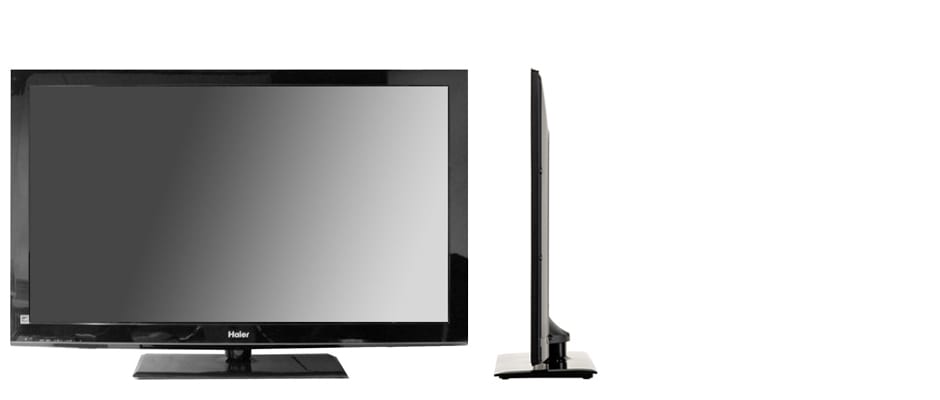Pros
Cons
Introduction
Overall Design
{{section_header}}{{section.name}}{{/section_header}}
Haier is employing some LED lights to make the {{product.model}} super slim. Less than two inches in depth, this TV looks good from the side, but the bezel running around the screen is pretty bold. The black frame bezel takes up a good amount of visual space. It somewhat detracts from the purpose of LED slimness. All together, it's a rather average looking television with a tight little profile.
Front
{{section_header}}{{section.name}}{{/section_header}}

Back
{{section_header}}{{section.name}}{{/section_header}}

Sides
{{section_header}}{{section.name}}{{/section_header}}

Stand/Mount
{{section_header}}{{section.name}}{{/section_header}}
The stand is a sturdy black plastic affair, with some swivel action to the neck. You can twist it about 30º in either direction, which helps give access to the port connections on the back left side.

Controls
{{section_header}}{{section.name}}{{/section_header}}
What at first appear to be touch controls on the front, are in fact hidden manual controls along the bottom. They use the symbol convention of touch controls by having the words for the controls written on the bezel, and they fooled us. We were tapping the bezel for a while before we reached underneath and found real buttons. They are a bit hard to distinguish by feel in the dark, and the labeling won't help you in that scenario either.

Remote Control
{{section_header}}{{section.name}}{{/section_header}}
The remote is very basic, controlling over-the-air channel changing, volume controls, the simple menu system, and USB playback. There is no backlighting and it cannot be programmed to control other devices, like a DVD player or the cable box. It is one of those remotes you put in a closet and never see again once you get the cable box remote to control volume and the on/off button.

In the Box
{{section_header}}{{section.name}}{{/section_header}}
In the box was a remote, batteries, a TV, a stand, a basic users manual and some warranty documents.
Black Level
{{section_header}}{{section.name}}{{/section_header}}
We recorded a very deep black level on the {{product.name}}. A reading of 0.05 cd/m2 rivals some plasma screen models, which are known for getting deeper black levels than LCDs.
This comes with a caveat, because we noticed some auto-dimming. When the screen showed mostly black, we saw the LED backlights turning down. So, if the screen is mostly black, the {{product.model}} will show a very low luminance because the backlights are dimming. More on how we test black level.
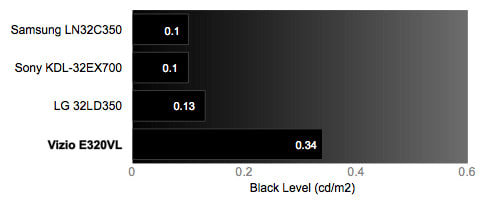
Peak Brightness
{{section_header}}{{section.name}}{{/section_header}}
The peak brightness on the {{product.model}} was nothing special. You will see that comparable LCD models in the chart below, can get much brighter. However, luminance works on a logarithmic scale such that small numerical differences in black level are far more noticeable than large numerical differences in peak brightness. This plays out in our contrast ratio section. More on how we test peak brightness.
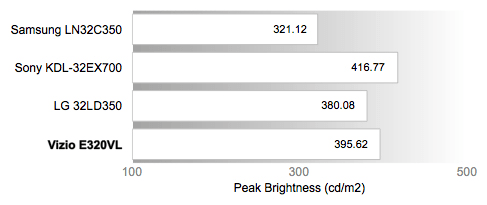
Contrast
{{section_header}}{{section.name}}{{/section_header}}
The {{product.model}} has a strong contrast ratio, keeping up with the competition in the chart below. Over 5000:1 is great on any scale. You can see that this Haier model has achieved a contrast ratio much the same as other models while not shining nearly as brightly. This is because of a 0.03, or 0.01, difference in black level, which has a huge impact on the range of values used to create a stark picture. More on how we test contrast.

Tunnel Contrast
{{section_header}}{{section.name}}{{/section_header}}
We test the black level at the center of the screen, while filling the screen with less and less black, to see if the black level stays consistent given different areas of black displayed. This is a test to see if the screen is dimming or brightening depending on what is shown. You can see that there is a slight downward trend of the line in the chart, as black fills the screen. This is evidence of the dimming we talked about in the black level section, showing that the backlights turn down as the screen fills with dark values. More on how we test tunnel contrast.
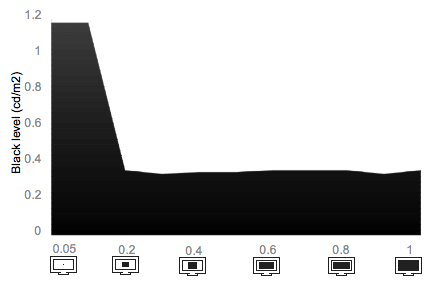
White Falloff
{{section_header}}{{section.name}}{{/section_header}}
Akin to the tunnel contrast test, we look to see if the peak brightness changes depending on how much of the screen shows white. The chart shows the reverse of what happened in the tunnel contrast test. The brightness of white values increases as more white is shown on the screen.
This auto-dimming function could not be turned off. It is not mentioned in the manual, nor is it an available option in the menus. More on how we test white falloff.
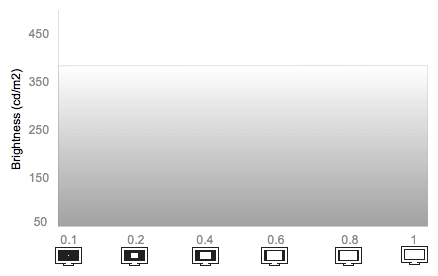
Uniformity
Greyscale Gamma
{{section_header}}{{section.name}}{{/section_header}}
This grayscale graph is one of the worst we have seen for a television. The graph represents the detail of brightness values used along the spectrum from darkest to brightest. Ideally, the slope of this line should be 2.1, which would tell us that every value is incrementally and evenly related to every other value; that given an input, this television is reproducing the signal exactly as it was received.
Instead, this graph has a slope of 3.7, way outside the realm of acceptable. A higher slope just means a loss of detail throughout the spectrum. That great contrast ratio we talked about in the previous section means little when a television does not use all the values in its range. We saw this in both the highlights and the shadows when watching actual content. Dark hair and clothing became blankets of shadows, where highlights were not edges of well lit objects, but erasures on the screen.
Something far more destructive to the picture than this loss of detail was a completely incorrect reproduction of certain dark gray values. If you notice at the dark gray section of the graph, there is a hiccup in the line. When we looked at a gray value gradient from dark to light, we saw some of these values were not gray, but blue and red. Sound strange? Well, it is, and you can definitely see this when watching anything with heavy shadows. Almost every shadow has waves of very obvious blue and red flowing throughout, where only dark gray should be. The worst part about this, is that there are only a few values of gray used, because of the high slope to the gamma graph, and both these red and blue gray replacements are used very frequently as a result. This alone would be a reason to look for another television. More on how we test greyscale gamma.
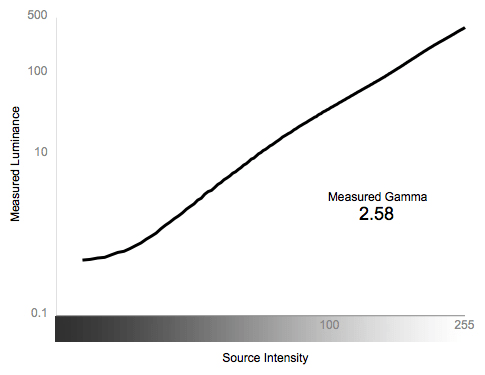
Color Temperature
{{section_header}}{{section.name}}{{/section_header}}
The {{product.model}} shows color temperature errors throughout the spectrum from light to dark. From the brightest values through the middle grays, there are warming errors where all pictures will be tinted slightly orange. The darkest values have the opposite error, and will show a blue tint due to an irregularly cool color temperature. More on how we test color temperature.

RGB Curves
{{section_header}}{{section.name}}{{/section_header}}
Each one of the graphs of the primary colors shows problems when transitioning in brightness from dark to light. They should all be smooth curves reaching from 0 to 100% brightness, with no bumps in the line.
The green values have a nice smoothness, but they are too dim throughout the spectrum. The line is so saggy that for about half of the spectrum it is almost horizontal. A horizontal line would represent no change in brightness from one input value to the next: a bright green jacket would look exactly the same as a faded green couch.
The red values start off increasing too quickly, then adjust into a horizontal plateau where no detail distinction will be made. They then increase too quickly again, to plateau again, before jumping straight up at the farthest right end of the chart.
The blue line behaves much the same as the red, but the plateaus occur at different points during the spectrum. The brightest values have an almost perfectly straight line where there will be no detail at all.
The final result of all this information combined will show as banding of colors rather than smooth gradient transitions. If you think of a gradient from dark to light, each one of these colors will have blocky sections of one color, instead of showing an even change throughout. Smooth transitions are absolutely necessary for showing a realistic 3D image on a 2D plane, which describes pretty much all content other than low quality cartoons. If you are buying a television only for the purpose of watching low quality cartoons, well, this one might work. More on how we test RGB curves.

You can see in the strips below much of what we discussed in the section above. Look for chunks of color, where in the ideal response there are none.
Motion Performance
{{section_header}}{{section.name}}{{/section_header}}
With the 120Hz function on, the motion processing was not bad. The motion smoothness we saw was better than the artifacts. For smoothness we look for detail retention in motion, and we saw none of the usual blurriness. In motion, tight lines remained separately rendered, faces did not become abstract, impressionistic representations, and small details like framed photographs in backgrounds were still identifiable. Our color chart trailed some colors, especially blue, leaving behind past frames as it moved across the screen. We detract points for color trailing.
There were some motion artifacts to mention. When a display adds elements to a picture that should not be there, like jagged edges, they are called artifacts. We saw jagged lines form on straight edges of objects. Jagged lines will show when an object does not move in unison, instead parts of it move, while others catch up. These jaggies result when a processor cannot refresh the screen fast enough, from top to bottom, to move an object all at once. The jagged edges increased as the difficulty of our tests increased. In our final test, we move a high density, high contrast pattern back and forth, something that is challenging for televisions because it requires full activation of a cell, then complete inactivation, in alternate fashion because these spots are moving across the screen. The jagged edges were the most noticeable with this test, and we had to detract points accordingly. More on how we test motion performance.
3:2 Pulldown & 24fps
{{section_header}}{{section.name}}{{/section_header}}
Televisions screens refresh on a factor of 30Hz, the {{product.name}} having a native refresh rate of 60Hz. When you drive the standard film frame rate of 24fps through a 60Hz screen, there needs to be some adjustment or else there will be flickering due to mismatched frame rates. Though there is no actual setting to change to tell the television to adjust to film frame rates, the {{product.model}} responded well to 24fps content, showing no flickering or increased judder. More on how we test 3:2 pulldown and 24fps.
Resolution Scaling
{{section_header}}{{section.name}}{{/section_header}}
A 1080p display, this Haier showed no real problems with resolution in its native resolution. We test it against the other standard video resolutions because most broadcast content is not yet at 1080p quality. Most HD television stations show a 720p picture, and any standard definition channel or content will come across at 480p. More on how we test resolution scaling.
480p
We recorded 4% overscan at 480p, but this resulted in no resolution problems. We saw no high density banding, where tight lines are improperly reproduced as banded together. Text was very legible and the highest possible detail was well displayed.
720p
720p showed the most problems, with 4% overscan. This time, overscan forced a mismapped picture onto a set matrix of pixels, resulting in noticeable issues. The signal came through at the correct resolution, but was incorrectly displayed such that some tight lines were falling between pixels. All of our high density patterns were banded together because of this mismatch. This will unfortunately show up with any of your HD channels. If someone on screen is wearing a checkered shirt or pinstripes, this may be reproduced incorrectly for some strange optical illusions.
Formats
{{section_header}}{{section.name}}{{/section_header}}
The {{product.name}} displays natively at 1080p and can handle all NTSC formats.
Viewing Angle
{{section_header}}{{section.name}}{{/section_header}}
This Haier showed us a strong viewing angle compared to similar LCD models. All LCD displays have trouble maintaining the contrast ratio off the center of the screen. This is due to the technology of the LCD crystals, which have narrow viewing cones. Any plasma TV would beat this score to a pulp, though.

Reflectance
{{section_header}}{{section.name}}{{/section_header}}
While watching content, we shine bright LED lights at the screen of our televisions from several angles and distances to see how annoying ambient light will be. The {{product.model}} did well here, not letting the light cast a haze over the entire picture, rather confining it to a tight diffuse glow.
Video Processing
{{section_header}}{{section.name}}{{/section_header}}
There are only two video processing modes on the {{product.model}}.
Calibration
{{section_header}}{{section.name}}{{/section_header}}
We made several adjustments to optimize the picture on the {{product.name}}. You can see our settings in the table below. We warn that the blue values were unfortunately lost to us. We tried many different settings, but the blue values maxed out before the highest possible signal input in all of them.

All of our calibration is done in conjunction with the DisplayMate software.
](http://www.displaymate.com/)
Video Modes
{{section_header}}{{section.name}}{{/section_header}}
There are a few video modes, but the manual does not describe for which situations these modes are to be used. Mild? For when you aren't eating sharp cheese? Or is it when you don't feel so spicy? Maybe it's a nice day outside.
Connectivity
{{section_header}}{{section.name}}{{/section_header}}
There is an L-shaped cutout with a standard set of port connections on the back left side of this Haier. The ports are broken into two sections, with the newer digital ports along the bottom of the L, and the analog connections on the side. On the bottom, there are three HDMI ports, and a USB connection, which should allow for hookups to many newer devices.

Along the side of the ports array, Haier gives you only one component or composite port because the two are shared. There is also a VGA connection for computer inputs, an antenna connection, a digital audio out, an analog audio in, and a headphone jack.
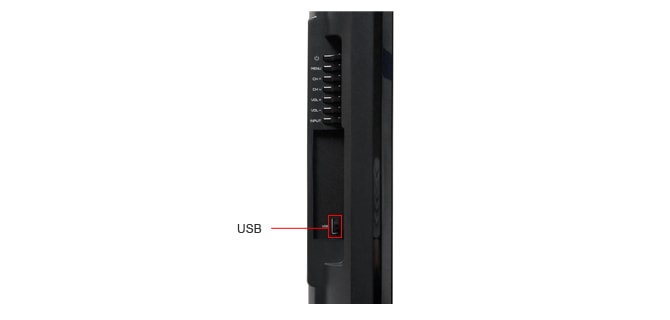
Placement
{{section_header}}{{section.name}}{{/section_header}}
The ports are on the back left side, which is fairly standard. We have questions about some of the choices, like the cable connection being on the side and the USB port on the bottom. The side we feel is generally reserved for devices that you may interchange frequently. The cable connection will probably not change ever, whereas you will have to plug and unplug a USB memory stick or device regularly if you plan to use it at all.
Audio Quality
{{section_header}}{{section.name}}{{/section_header}}
We were surprised to find that there are 10W speakers on this Haier. When we tested it, we felt pretty certain not even this much power was coming out of the {{product.model}}. The audio sounded especially canned. This may be due to the fancy hidden speakers. By keeping them out of sight, Haier may have also blocked the sound a little.
We watch content with quiet voices, ambient noises, and of course plenty of automatic rifle fire and rocket propelled grenades. Even the voices seemed to top out and were limited in range. The explosions were worse than what you could hear from an ancient Super Nintendo.
There is a surround mode on the {{product.model}}. We were further surprised by how well this worked. The sound did seem to come from several angles around us, instead of from the television itself. However, this did not improve the quality in the slightest. It was more like, hey where are those canned voices coming from? Is someone calling us on a cup phone? If you do decide to buy this TV, your experience will be greatly enhanced by buying a pair of external speakers.
Menu Interface
{{section_header}}{{section.name}}{{/section_header}}
The menus are crazy simple. They appear as a large gray box in the center of the screen. There are a few tab headers with options within each. With no advanced features of any kind (no internet, no 3D, not much in the way of video processing), the settings are very basic. In fact, after you calibrate once, you may never need to go back in to the menu.
Being in the center of the screen, it is hard to see how much adjustments affect the picture. However, there are not that many adjustments to make so this should not be a huge problem.

There is one curious aspect to the menu. There is a tab called Lock, which was mysteriously locked. The menu tells us you need a password to enter this menu. The default password is 0000, but we were never asked to input a password, rather the Lock menu was grayed out and we couldn't even select it. If you can access this menu, you can lock shows with of a given MPAA rating.

Instruction Manual
{{section_header}}{{section.name}}{{/section_header}}
The instruction manual is written in several languages, including poor English. An excerpt: Blue Screen: When the TV is no signal,You can the backgroundto blue or others ." There are other settings that are listed without explanation at all. It's not great, but the {{product.model}} is so simple that we can't imagine you will have to consult the manual for much other than connectivity help. You can grab a copy of the manual here under the Product Support & Downloads tab.

A manual for so many TV models, they have to be further categorized by type.
Internet Features
{{section_header}}{{section.name}}{{/section_header}}
There are no internet features on the {{product.name}}.
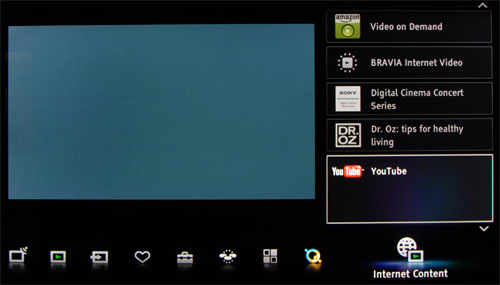
Local Media Playback
{{section_header}}{{section.name}}{{/section_header}}
There is a singular USB port located in the most inconvenient area on this television. It is on the back, on the underside of the ports L-shaped layout, the farthest away from the outside. It could not be more out of the way, but should you plan on using this media port, you will need to access it several times, which is several times more than any of the more sedentary connections.
More inconvenient is a rounded ridge that juts out about an inch below the port. This became a problem because our USB thumb drive is about an inch long, and we had to really wedge it into this small space to plug it into the {{product.model}}. We tried to connect a Flip camcorder as well, but this ridge made it wholly impossible because the connector could not fit into the miniscule hole. Furthermore, there is not enough space between the HDMI port next to the USB port to connect both an HDMI cable and a USB cable. We had to unplug our HDMI cable to even wedge our USB thumb drive in there.
We have never had a television actually fail to be connectable. We have seen systems that don't work that well, but none that prevent you from even making a connection.

The sad part about this awkward connection is that the media system works rather well. We played back an .mp3 and a .jpeg easily. It seems like many formats work, but there's no way to know this. The manual says nothing about supported file formats, nor does the website.
Pictures work in a slideshow format, but there is no way to control the transitions. You cannot accompy it with music either. There are buttons on the remote that control the slides manually however.
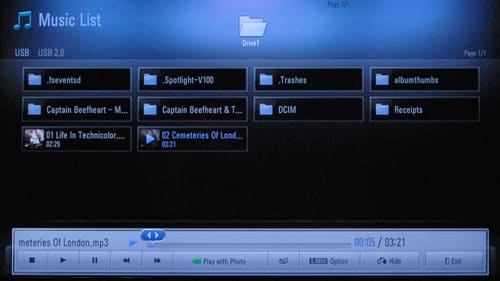
Power Consumption
{{section_header}}{{section.name}}{{/section_header}}
The {{product.name}} runs rather cheap for an average year of use. We would like to mention that our calibration seemed to use less energy than when set to Power Save in the picture settings menu. We are not sure how this works, but being that we could not adjust the backlight at all, we just want to let you know that this Haier will cost about $16.60 in electricity per year.
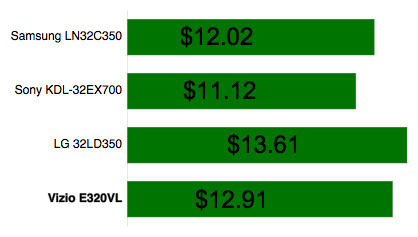
Value Comparison
{{section_header}}{{section.name}}{{/section_header}}
The Sony Bravia KDL-46BX420 is a simple TV without the fuss (or benefits, depending on how you view it) of a lot of features. There's a lot of value here, as the performance was good in most areas and the $899 MSRP is quite reasonable. We can hardly say the same of the {{product.name}}, which is overpriced and under-performing.
Blacks & Whites
{{section_header}}{{section.name}}{{/section_header}}
The {{product.name}} produced a decent contrast ratio, but only because of some funky auto-dimming. The actual performance you can expect in real life is pretty disappointing. Certain dark greys, like in the folds of someone's clothes, would unexpectedly produce blue and red tones. The Sony BX420 was vastly better.

Color Accuracy
{{section_header}}{{section.name}}{{/section_header}}
Again, in color performance, the Sony is quite superior to the {{product.name}}. The Haier, in fact, seemed entirely incapable of producing smooth color transitions.
Motion
{{section_header}}{{section.name}}{{/section_header}}
The motion performance was a rare bright spot for the Haier, in that it did not fail the test utterly. Both TVs showed some artifacting, but nothing too distracting.
Viewing Effects
{{section_header}}{{section.name}}{{/section_header}}
The {{product.name}} and Sony BX420 are both LCD TVs, and as such don't have the best viewing angles. The Sony was definitely narrower though, which means that viewers sitting to the side will miss out on a lot of the contrast ratio and color performance.
Connectivity
{{section_header}}{{section.name}}{{/section_header}}
The {{product.name}} has one additional HDMI compared to the Sony BX420, but is similar in most other respects. That said, the port placement on the Haier is pretty bad, especially the impossible-to-reach USB port.
Value Comparison
{{section_header}}{{section.name}}{{/section_header}}
The Toshiba 40E210U has all the hallmarks of an entry-level TV – the aesthetics aren't very slick, the menus are clunky, the connectivity options are minimal. etc. However, the core performance is good. That spells value to us. It's a far better choice than the {{product.name}}, which is overpriced and can't come close what we saw from the Toshiba.
Blacks & Whites
{{section_header}}{{section.name}}{{/section_header}}
The Toshiba offers a great black level for an LCD TV, as well as pretty good detail in the shadows and a smooth greyscale gamma. The {{product.name}}, on the other hand, produced false coloration in the shadows – an error we almost never see and impossible to ignore.

Color Accuracy
{{section_header}}{{section.name}}{{/section_header}}
In our color tests, the Toshiba showed a little difficulty displaying bright reds, but was otherwise a solid performer. The {{product.name}}, however, completely fell apart in our color tests, producing some of the worst color curves we've seen.
Motion
{{section_header}}{{section.name}}{{/section_header}}
Both LCD televisions, the Haier and the Toshiba both showed some issues with judder when objects were in motion, but nothing too terrible.
Viewing Effects
{{section_header}}{{section.name}}{{/section_header}}
The {{product.name}} and Toshiba 40E210U have almost identical viewing angles, and neither are very good.
Connectivity
{{section_header}}{{section.name}}{{/section_header}}
Both of these TVs have pretty basic options for connectivity, but the ports on the Toshiba are much easier to access.
Value Comparison
{{section_header}}{{section.name}}{{/section_header}}
Depending on where you look, the Samsung LN46D550 is slightly more expensive than the {{product.name}}. We think the extra money is absolutely worth the investment. To get a television that does not show blue and red waves throughout all shadows and over all rounded edges is worth a few more bills. Yet, the Samsung LN46D550 is more than just not bad, it provides some real quality in terms of color reproduction and strong shadow detail.
Blacks & Whites
{{section_header}}{{section.name}}{{/section_header}}
These two televisions have remarkably similar contrast ratios. Both of them are very good, but the {{product.name}} uses auto-dimming to achieve a low black level, so its contrast ratio is slightly fraudulent.

Color Accuracy
{{section_header}}{{section.name}}{{/section_header}}
The {{product.name}} has a slightly more accurate color gamut than the Samsung LN46D550. The Samsung has a more accurate color temperature and far better color curves showing much more detail and consistency of color.
Motion
{{section_header}}{{section.name}}{{/section_header}}
We were a little disappointed with the motion processing capabilities of the Samsung LN46D550. Moving objects lost a significant amount of detail and we saw some serious artifacts. The {{product.name}} on the other hand did rather well here.
Viewing Effects
{{section_header}}{{section.name}}{{/section_header}}
The {{product.name}} had a better viewing angle than the Samsung LN46D550, one of its only benefits.
Connectivity
{{section_header}}{{section.name}}{{/section_header}}
The Samsung LN46D550 has more HD and analog ports than the {{product.name}} as well as access to DLNA via Ethernet port or an optional wireless adapter.
Conclusion
The {{product.model}} ($929 MSRP, sold for about $699 online at time of publication) is a very basic 1080p LED backlit television. You cannot access the internet, nor can you watch 3D images with this television. Lacking advanced features can often be a boon to a television, making it easy to use and cost much less, but that is not the case here.
Unfortunately, there isn't anything to like about this television. Every supposed benefit comes with severe drawbacks. The LED lights make for a thin profile, but this TV is far from fashionable, what with its unsightly bezel. The contrast ratio is strong, but only because of an auto-dimming feature that cannot be turned off. The {{product.model}} produces a set of colors that are fairly accurate, but the color temperature is inconsistent, and the color gradients are not smooth at all.It cannot process a 720p video resolution well, a common resolution for HD content. There is a great USB media port with an easy-to-use interface, but the physical location of this port makes it almost inaccessible.
We think the worst aspect of this television is that certain grey values reproduced as blue and red instead of pure grey. This became so obvious to us, after we saw it the first time, that it was really distracting. We cannot see any piece of content without seeing red and blue waves throughout the picture. There is much to be said for a bargain TV, but it's not a true bargain if you come to regret the purchase because of poor quality. Sadly, we cannot recommend this television to anyone.
Model Series Comparison
{{section_header}}{{section.name}}{{/section_header}}
The manual lists two televisions in this series, one is the LE46B1381 and the LE42B1380. Both screens are 1080p televisions with three HDMI ports and a USB media port. The biggest difference, other than screen size, between these two is that the LE46B1381 (reviewed here) is the only one with the 120Hz motion interpolation function.
Photo Gallery
{{photo_gallery "Front Tour Image", "Back Tour Image", "Sides Tour Image", "Stand Photo", "Controls Photo", "Remote Control Photo", "Connectivity Tour Image 1", "Connectivity Tour Image 2", "Connectivity Extra Photo", "Menu Main Photo", "Menu 2 Photo", "Internet Features 1 Photo", "Internet Features 2 Photo", "Internet Features 3 Photo", "Local Media Playback 1 Photo", "Local Media Playback 2 Photo"}}
Ratings & Specs
{{manufacturer_specs_table}}
Meet the tester
Christian Sherden is a valued contributor to the Reviewed.com family of sites.
Checking our work.
Our team is here to help you buy the best stuff and love what you own. Our writers, editors, and experts obsess over the products we cover to make sure you're confident and satisfied. Have a different opinion about something we recommend? Email us and we'll compare notes.
Shoot us an email